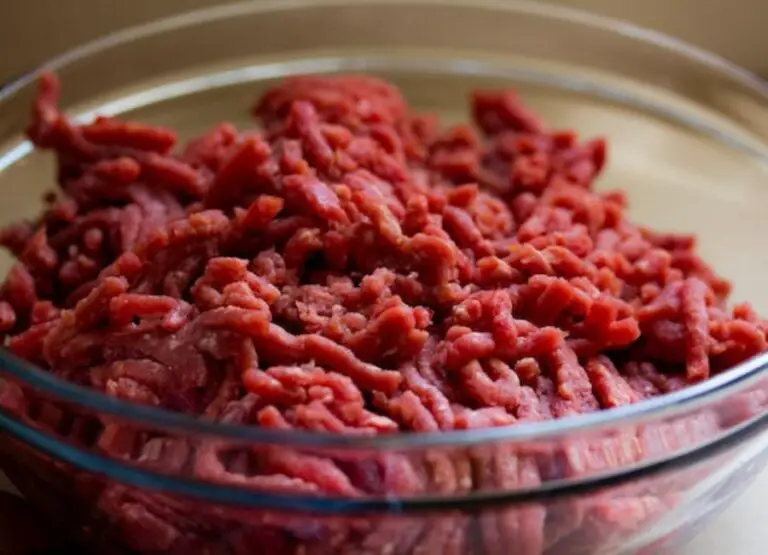Eating Undercooked Beef Symptoms
Eating beef that isn’t fully cooked might have negative effects. Undercooked beef consumption can lead to a number of foodborne diseases, some of which can be fatal.
The signs and risks of eating undercooked beef will be covered in this blog article, along with advice on how to prepare beef safely and correctly.
We’ll also go through the ideal meat cooking temperatures and what to do if you think you may have eaten an undercooked steak. When this article is finished, you’ll have
What is undercooked beef?
Undercooked beef is beef that has not been cooked to the required temperature or time to ensure that it is safe to eat.
Undercooked beef can carry bacteria and other pathogens that can cause foodborne illness, so it is important to make sure that beef is cooked to the proper temperature and for the correct amount of time.
The recommended minimum internal temperature for beef is 145 °F (63 °C) for 3 minutes, and ground beef should be cooked to at least 165 °F (74 °C).
Eating Undercooked Beef Symptoms
The following are some common symptoms of undercooked beef:
- Nausea: Having the urge to throw up or feeling sick in one’s stomach is referred to as nausea. It frequently comes with a stomach ache.
- Abdominal discomfort: This pain in the belly, which can be acute, dull, or cramping, is frequently brought on by gastrointestinal irritation.
- Diarrhea: Food poisoning frequently manifests as diarrhea, which is characterized by frequent, loose, and watery feces.
- Vomiting: The process of forcing the stomach’s contents into the mouth is known as vomiting. It frequently indicates food poisoning.
- Stomach cramps: Abdominal discomfort is frequently present together with stomach cramps, which are a tight or hurting sensation in the stomach.
- Headache: This is a discomfort in the head that can be brought on by a number of things, such as electrolyte imbalances, dehydration, and food poisoning.
- Fatigue: Fatigue is a state of being worn out or having little energy, which might result from the body battling an illness.
- Dizziness: Dizziness is a sensation of being lightheaded or unsteady that can be brought on by a variety of things, including dehydration and low blood pressure.
- Muscle aches: This discomfort or soreness in the muscles can be brought on by a variety of conditions, such as electrolyte imbalances, dehydration, and food poisoning.
- Low-grade fever: This moderate elevation in body temperature may signal an underlying illness or inflammation.
Dangers of eating undercooked beef
Eating undercooked beef can pose a number of dangers, including the following:
- Foodborne disease: Beef can contain dangerous bacteria and parasites including Escherichia coli (E. coli), Salmonella, and Listeria that can lead to foodborne sickness if it is consumed raw or undercooked. Frequent symptoms include fever, nausea, vomiting, diarrhea, and abdominal discomfort.
- Spread of foodborne pathogens: If a person handles food or prepares meals for others, eating undercooked beef can cause the spread of dangerous infections to other people.
- Toxins: Some bacteria and parasites are capable of producing harmful toxins, even in minute quantities.
- Anemia: Anemia is a disorder marked by low quantities of hemoglobin and red blood cells in the blood, which can be brought on by parasites like Anisakis.
- Kidney failure: E. coli is one bacteria that can cause kidney failure, which can result in major health issues and even death.
- Neural damage: Listeria, a kind of bacterium frequently found in undercooked beef, can harm the nervous system and even result in death, particularly in pregnant women, the elderly, and people with compromised immune systems.
It is important to cook beef thoroughly to reduce the risk of foodborne illness and to avoid the dangers associated with consuming undercooked beef.
Prevention of Eating Undercooked Beef
There are two important steps to take when preventing the eating of undercooked beef:
Proper Cooking Techniques
This involves:
- Use a Meat Thermometer: To ensure that beef is cooked to a safe internal temperature, a meat thermometer is a necessary tool. To eradicate any hazardous germs, the USDA advises cooking beef for at least 3 minutes at a temperature of 145 °F.
- Prepare to Safe Internal Temperatures: It’s critical to cook beef to the suggested safe internal temperatures in order to prevent foodborne disease. This includes cooking roasts to 145 °F for medium-rare and 160 °F for well-done, as well as ground beef to 160 °F.
- Let Meat Rest Before Serving: It’s crucial to give the meat some time to rest once it reaches the proper internal temperature before slicing or serving. This allows the meat’s internal temperature to distribute evenly, reducing the risk of undercooked areas.
Safe Food Handling Practices
This includes:
- Wash Your Hands Regularly: Washing your hands frequently, especially before handling food, is one of the best strategies to prevent foodborne disease. This aids in getting rid of any dangerous bacteria that can be on your hands.
- Properly Store Meat: Meat storage is essential for preventing contamination and foodborne disease. To prevent cross-contamination, raw meat should be stored separately from other foods and refrigerated at 40°F or lower.
- Prevent Cross-Contamination: When raw meat comes into touch with other food products, such as cutting boards, utensils, or kitchen countertops, cross-contamination can happen. It’s crucial to meticulously clean and sterilize all surfaces and utensils that come into touch with raw meat in order to avoid this.
You may lower your chance of contracting a foodborne disease and guarantee that your beef is cooked to a healthy internal temperature by using correct cooking methods and safe food handling procedures.
Learn more about the washing of beef before cooking.
Importance of Cooking Beef Thoroughly
Cooking beef thoroughly is important for both food safety and the health of individuals who consume it.
Cooking beef properly is vital because raw or undercooked beef can contain hazardous germs and parasites that can cause foodborne diseases.
Escherichia coli (E. coli), Salmonella, and Listeria are a few of the typical germs discovered in undercooked meat.
These bacteria can produce signs including fever, nausea, vomiting, diarrhea, and abdominal discomfort.
When a foodborne disease is severe, it can result in more significant health issues such as renal failure, anemia, and even death.
Cooking beef completely helps guarantee that the meat is safe to consume and free of hazardous microorganisms, in addition to preventing foodborne sickness.
Additionally, it aids in eliminating any potential parasites from the flesh. Furthermore, thorough cooking enhances the beef’s flavor, texture, and general quality.
Causes of Food Poisoning from Undercooked Beef
Undercooked beef may make you sick since it contains dangerous germs and parasites. Undercooked beef is a frequent source of food illness, including:
- Bacteria: Raw or undercooked beef may contain bacteria that can make you sick, including Escherichia coli (E. coli), Salmonella, and Listeria.
- Parasites: Beef can include parasites including Toxoplasma gondii and Anisakis, which can lead to foodborne disease when consumed raw or undercooked.
- Cross-contamination: When raw beef comes into touch with other foods, such as fruits and vegetables, germs and parasites can spread, resulting in cross-contamination.
- Poor food handling: Poor food handling can raise the risk of food illness by not washing hands after handling raw meat or storing it improperly.
- Improper cooking: Improper cooking can lead to undercooked beef and the presence of dangerous germs and parasites. One example of improper cooking is failing to use a meat thermometer to verify that the beef is cooked to a healthy internal temperature.
What happens if you eat undercooked meat
If you eat undercooked meat, you are at risk of consuming harmful bacteria such as Salmonella, E. coli, and Listeria, which can cause food poisoning.
Symptoms of food poisoning from undercooked meat include nausea, vomiting, diarrhea, abdominal cramps, and fever.
In severe cases, food poisoning can lead to more serious health complications and can be life-threatening, especially for young children, older adults, and people with weakened immune systems.
Frequently Asked Questions
How can I avoid getting food poisoning from undercooked beef?
It’s crucial to cook beef to the required internal temperature of at least 145 °F (63 °C) for steaks and roasts and 160 °F (71 °C) for ground beef in order to avoid food poisoning from undercooked meat.
Additionally, it’s critical to maintain proper food cleanliness and refrain from mixing raw meat with other ingredients.
Is it possible to become ill with raw beef if I have no symptoms?
Yes, undercooked meat may get you sick even if you don’t show any symptoms. Asymptomatic carriers of dangerous germs can still transmit the disease to others.
To lower the danger of contracting a foodborne disease, it’s crucial to constantly abide by food safety regulations and cook beef to the proper internal temperature.
Can food poisoning be caused by undercooked beef?
Yes, hazardous germs like E. coli or Salmonella that cause food poisoning can be found in undercooked beef.
How long do symptoms take to show up after consuming undercooked beef?
Undercooked beef symptoms might emerge anywhere from a few hours to many days after intake.
What should I do if I think undercooked meat is the source of my food poisoning?
It’s crucial to get medical assistance as soon as you can if you believe that undercooked meat may have caused your food poisoning. Drink plenty of water and use over-the-counter drugs to treat symptoms.
What signs indicate undercooked meat consumption?
Undercooked beef can cause symptoms such as headache, fever, nausea, vomiting, diarrhea, and stomach discomfort. In extreme circumstances, it can also result in blood poisoning and dehydration.
Can you die from eating raw meat?
Yes, consuming raw meat can result in death. Salmonella, E. coli, and Listeria are three dangerous bacteria that can be found in raw meat and cause food poisoning.
When food poisoning is severe, it can result in fatal illnesses including sepsis and renal failure.
Consuming raw beef can have major health repercussions for older persons, children, and people with compromised immune systems.
To guarantee that meat is safe to consume and that any hazardous germs have been eliminated, it must be cooked to an internal temperature of at least 145 °F for chicken, 160 °F for ground beef, and 145 °F for beef, hog, and lamb.
Conclusion
In conclusion, it’s critical to understand the dangers of consuming undercooked beef.
You may assist safeguard your health by making sure your beef is cooked to the proper temperature and avoiding potential causes of foodborne diseases.
Remember that foodborne infections may be dangerous, so it’s crucial to get help immediately if you think you may have eaten undercooked meat.
With the correct information and safety measures, you may eat a satisfying and healthy dinner without having to be concerned about the possible negative effects of consuming undercooked beef.
Further reading…
- Food Safety Focus
- USDA.gov on dangers of undercooked meat.
- Healthline on raw meat
- SFGATE on raw meat


![How Long Can Raw Meat Sit In The Fridge [Answered]](https://foodcreeks.com/wp-content/uploads/2023/03/How-Long-Can-Raw-Meat-Sit-In-The-Fridge-768x555.jpg)
![Do Smoked Meats Need To Be Refrigerated [Answered]](https://foodcreeks.com/wp-content/uploads/2023/03/Do-Smoked-Meats-Need-To-Be-Refrigerated-768x555.jpg)

![What Happens If You Eat Raw Ham [Answered]](https://foodcreeks.com/wp-content/uploads/2023/03/What-Happens-If-You-Eat-Raw-Ham-768x555.jpg)


